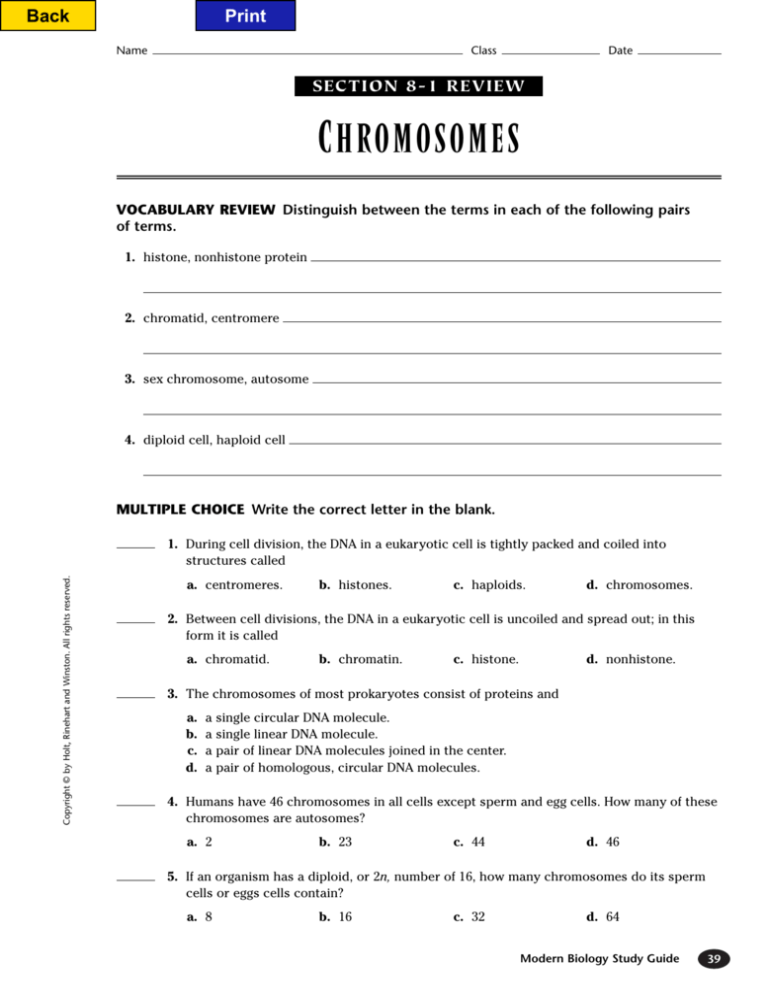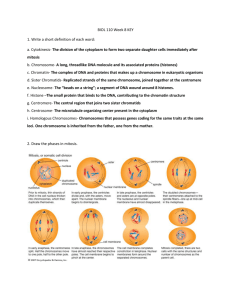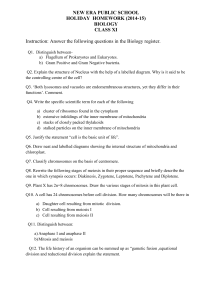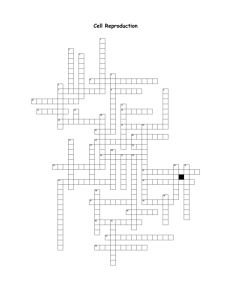
Back
Print
Name
Class
Date
SEC T I O N 8 - 1 R E VIEW
C HROMOSOMES
VOCABULARY REVIEW Distinguish between the terms in each of the following pairs
of terms.
1. histone, nonhistone protein
2. chromatid, centromere
3. sex chromosome, autosome
4. diploid cell, haploid cell
MULTIPLE CHOICE Write the correct letter in the blank.
Copyright © by Holt, Rinehart and Winston. All rights reserved.
1. During cell division, the DNA in a eukaryotic cell is tightly packed and coiled into
structures called
a. centromeres.
b. histones.
c. haploids.
d. chromosomes.
2. Between cell divisions, the DNA in a eukaryotic cell is uncoiled and spread out; in this
form it is called
a. chromatid.
b. chromatin.
c. histone.
d. nonhistone.
3. The chromosomes of most prokaryotes consist of proteins and
a.
b.
c.
d.
a single circular DNA molecule.
a single linear DNA molecule.
a pair of linear DNA molecules joined in the center.
a pair of homologous, circular DNA molecules.
4. Humans have 46 chromosomes in all cells except sperm and egg cells. How many of these
chromosomes are autosomes?
a. 2
b. 23
c. 44
d. 46
5. If an organism has a diploid, or 2n, number of 16, how many chromosomes do its sperm
cells or eggs cells contain?
a. 8
b. 16
c. 32
d. 64
Modern Biology Study Guide
39
Back
Print
Name
Class
Date
SHORT ANSWER Answer the questions in the space provided.
1. What role do proteins play in enabling the enormous amount of DNA in a eukaryotic cell to fit
into the nucleus, and what are those proteins called?
2. In what ways are homologous chromosomes similar?
3. What is the picture below called, and how is it used to determine the sex of a person?
1
2
3
4
5
6
7
8
9
10
11
13
14
15
16
17
18
19
20
21
22
12
XY
STRUCTURES AND FUNCTIONS The diagram below shows structures isolated from the
nucleus of a dividing eukaryotic cell. Label each structure or pair of structures in the
space provided.
a
b
c
d
40
Section 8-1 Review
Copyright © by Holt, Rinehart and Winston. All rights reserved.
4. Critical Thinking Some relatively simple eukaryotes, such as the adder’s tongue fern, may have
many more chromosomes than a more complex eukaryote, such as a mammal. What might this
suggest about the size and organization of chromosomes in different species?
Back
Print
Name
Class
Date
SEC T I O N 8 - 2 R E VIEW
C ELL D IVISION
VOCABULARY REVIEW Circle the term that does not belong in each of the following
groups, and briefly explain why it does not belong.
1. G1 phase, G2 phase, S phase, telophase
2. anaphase, interphase, metaphase, prophase
3. binary fission, mitosis, meiosis, cytokinesis
4. cleavage furrow, cytokinesis, spindle fiber, cell plate
Copyright © by Holt, Rinehart and Winston. All rights reserved.
5. centrioles, vesicles, kinetochore fibers, polar fibers
MULTIPLE CHOICE Write the correct letter in the blank.
1. Prokaryotic cells reproduce by a process called
a. mitosis.
b. meiosis.
c. binary fission.
d. binary fusion.
2. In eukaryotic cells, DNA is copied during a phase of the cell cycle called
a. M phase.
b. S phase.
c. G1 phase.
d. G2 phase.
3. The cytoplasm of a eukaryotic cell divides by a process called
a. mitosis.
b. meiosis.
c. replication.
d. cytokinesis.
4. The fibers that extend from centrosome to centrosome during mitosis are
a. polar fibers.
b. spindle fibers.
c. kinetochore fibers. d. binary fibers.
5. In the G0 phase, cells
a. synthesize DNA.
b. prepare for cell division.
c. exit from the cell cycle.
d. move their chromosomes to the
cell equator.
Modern Biology Study Guide
41
Back
Print
Name
Class
Date
SHORT ANSWER Answer the questions in the space provided.
1. List the five main phases of the cell cycle, and briefly explain what occurs during each phase.
2. List the four phases of mitosis, and briefly explain what occurs during each phase.
3. Describe cytokinesis in a plant cell.
G1 phase during their cell cycle? Explain.
STRUCTURES AND FUNCTIONS In the spaces provided below, label each figure with the
phase of mitosis that it represents.
a
42
b
Section 8-2 Review
c
d
Copyright © by Holt, Rinehart and Winston. All rights reserved.
4. Critical Thinking What would happen to a cell and its offspring if the cells did not go through a
Back
Print
Name
Class
Date
SEC T I O N 8 - 3 R E VIEW
M EIOSIS
VOCABULARY REVIEW Define the following terms.
1. oogenesis
2. tetrad
3. independent assortment
4. polar bodies
MULTIPLE CHOICE Write the correct letter in the blank.
1. During synapsis, the
Copyright © by Holt, Rinehart and Winston. All rights reserved.
a. DNA in each chromosome is copied.
b. spindle fibers disappear.
c. cytoplasm divides.
d. chromosomes line up next to their
homologues.
2. During crossing-over, portions of chromatids
a. double the amount of DNA in
each chromosome.
b. move from autosomes to
sex chromosomes.
c. break off and attach to adjacent chromatids on the homologous chromosome.
d. separate from each other and move to
opposite poles of the cell.
3. In which phase of meiosis do tetrads form?
a. prophase I
b. telophase I
c. metaphase II
d. anaphase II
4. Meiosis II
a. is preceded by the copying of DNA.
b. separates chromatids into opposite
poles of the cell.
c. separates homologous chromosomes
into opposite poles of the cell.
d. produces diploid offspring cells.
5. In oogenesis, a diploid reproductive cell divides meiotically to produce
a. one diploid gamete.
b. four diploid gametes.
c. one haploid gamete.
d. four haploid gametes.
Modern Biology Study Guide
43
Back
Print
Name
Class
Date
SHORT ANSWER Answer the questions in the space provided.
1. Describe two ways in which genetic recombination occurs during meiosis.
2. List the four phases of meiosis I, and briefly explain what occurs during each phase.
3. How do the products of meiosis I differ from those of meiosis II?
4. Critical Thinking What are one advantage and one disadvantage of asexual reproduction
STRUCTURES AND FUNCTIONS In the spaces provided below, label each figure with the
phase of meiosis that it represents.
a
44
b
Section 8-3 Review
c
d
Copyright © by Holt, Rinehart and Winston. All rights reserved.
compared with sexual reproduction?
Back
Print
Section 7-1
Section 8-1
VOCABULARY REVIEW
1. Cellular respiration is the process in which cells
make ATP by breaking down organic compounds.
2. Glycolysis is a biochemical pathway in which one
molecule of glucose is oxidized to two molecules
of pyruvic acid.
3. Lactic acid fermentation is an anaerobic pathway
in which pyruvic acid is converted into lactic acid.
4. Alcoholic fermentation is an anaerobic pathway in
which pyruvic acid is converted into ethyl alcohol
and CO2.
VOCABULARY REVIEW
1. Histones help maintain the shape of a chromosome
and aid in the tight packing of DNA; nonhistone proteins control the activity of specific regions of DNA.
2. A chromatid is one-half of a chromosome;
a centromere is the area of a chromatid that holds
the two chromatids in a chromosome together.
3. A sex chromosome is a chromosome that determines the sex of an organism; an autosome is any
other chromosome.
4. A diploid cell has both chromosomes in each
homologous pair; a haploid cell has only one
chromosome in each homologous pair.
MULTIPLE CHOICE
1. a
2. c
3. d
4. b
5. c
SHORT ANSWER
1. The fermentation pathways can operate in the
absence of oxygen.
2. The energy-containing products are NADH, ATP,
and pyruvic acid.
3. These pathways regenerate NAD, which the cells
can use to keep glycolysis going to make more
ATP in the absence of oxygen.
4. Without niacin or the ability to make it, the
person would be deficient in NAD. Since NAD
is used in Step 3 of glycolysis, glycolysis would
be inhibited.
STRUCTURES AND FUNCTIONS
a, glucose; b, glycolysis; c, pyruvic acid;
d, lactic acid fermentation; e, alcoholic
fermentation; f, lactic acid; g, ethyl alcohol
5. c
SHORT ANSWER
1. Most of the energy is acquired by NADH; three molecules are produced during each turn of the cycle.
2. The reactions of the electron transport chain
occur in the inner mitochondrial membrane.
3. C6H12O6 + 6O2 → 6CO2 + 6H2O + energy
4. The mitochondrial membranes segregate the
enzymes and reactants of the Krebs cycle, facilitating the reactions they participate in. The folding of the inner mitochondrial membrane provides
a large surface area for the molecules of the electron transport chain. The area between the inner
and outer mitochondrial membranes provides a
confined space in which protons can accumulate,
driving chemiosmosis.
STRUCTURES AND FUNCTIONS
a, protons; b, protons; c, protons; d, NAD+; e, FADH2;
f, O2; g, ADP + phosphate
6
5. a
SHORT ANSWER
1. Histones help coil and package the DNA into a
very small volume.
2. Homologous chromosomes are the same size and
shape and carry genes for the same traits.
3. The picture is called a karyotype. If it shows two
X chromosomes, the person is a female; if it shows
one X and one Y chromosome, the person is a male.
4. Relatively simple organisms with more chromosomes might have smaller chromosomes containing less DNA. Also, some of the DNA in an
organism’s chromosomes may not carry information that is actually used by the organism.
Modern Biology Study Guide Answer Key
Section 8-2
VOCABULARY REVIEW
1. Telophase does not belong; it is a phase of mitosis,
and the other three are phases of interphase.
2. Interphase does not belong; it is a phase of the cell
cycle, and the other three are phases of mitosis.
3. Binary fission does not belong; it pertains to
prokaryotes, and the other three pertain to
eukaryotes.
4. Spindle fiber does not belong; it pertains to
nuclear division, and the other three pertain to
cytoplasmic division.
5. Vesicles does not belong; vesicles are organelles,
some of which participate in cytoplasmic division,
and the other three are involved in nuclear division.
MULTIPLE CHOICE
1. c
2. b
3. d
4. a
5. c
SHORT ANSWER
1. G1 phase: the cell grows. S phase: DNA is copied. G2
phase: the cell prepares for cell division. Mitosis: the
nucleus divides. Cytokinesis: the cytoplasm divides.
2. Prophase: the chromatin coils and forms chromosomes, the nucleolus and nuclear envelope disappear, and the mitotic spindle forms. Metaphase:
kinetochore fibers move the chromosomes to the
cell equator. Anaphase: the chromatids in each
chromosome separate and move toward opposite
poles of the cell. Telophase: the mitotic spindle
disappears, the chromatids unwind to form chromatin, the nuclear envelope reforms, and a
nucleolus appears.
Copyright © by Holt, Rinehart and Winston. All rights reserved.
VOCABULARY REVIEW
1. Aerobic respiration is the set of pathways in cellular
respiration that require oxygen to break down
pyruvic acid.
2. The mitochondrial matrix is the space inside the
inner membrane of a mitochondrion.
3. The Krebs cycle is a biochemical pathway that
breaks down acetyl coenzyme A, producing CO2,
hydrogen atoms, and ATP.
4. FAD, or flavine adenine dinucleotide, is a molecule
that accepts electrons during redox reactions.
4. d
4. c
STRUCTURES AND FUNCTIONS
a, chromosome; b, centromere; c, chromatids;
d, homologous chromosomes, or homologues
Section 7-2
MULTIPLE CHOICE
1. b
2. c
3. a
MULTIPLE CHOICE
1. d
2. b
3. a
Back
Print
3. Vesicles formed by the Golgi apparatus fuse at
the midline of the cell to form the cell plate, a
cell wall that elongates to separate the cell into
two cells.
4. Without a G1 growth phase, the cells would not
grow to their mature size after cytokinesis.
Therefore, the offspring cells would become
smaller with each cell cycle.
STRUCTURES AND FUNCTIONS
a, telophase; b, metaphase; c, prophase; d, anaphase
Section 8-3
VOCABULARY REVIEW
1. Oogenesis is the production of mature egg cells,
or ova.
2. A tetrad is a pair of homologous chromosomes lined
up next to each other during prophase I of meiosis.
3. Independent assortment is the random separation
of homologous chromosomes during anaphase I.
4. Polar bodies are haploid offspring cells produced
by meiosis during oogenesis.
Copyright © by Holt, Rinehart and Winston. All rights reserved.
MULTIPLE CHOICE
1. d
2. c
3. a
4. b
5. c
SHORT ANSWER
1. Genetic recombination occurs during crossingover and independent assortment.
2. Prophase I: DNA coils into chromosomes, the nucleolus and nuclear envelope disappear, the mitotic
spindle forms, and synapsis and crossing-over occur.
Metaphase I: the tetrads line up randomly along the
midline of the cell, and spindle fibers attach to the
centromere of each homologue. Anaphase I: the
homologues move toward opposite poles of the cell.
Telophase I: the chromosomes reach the opposite
ends of the cell, and cytokinesis begins.
3. In meiosis I, the offspring cells are haploid but
each cell contains two copies of the chromosome
because the original cell copied its DNA before
meiosis I. The offspring cells of meiosis II are also
haploid, but each cell contains only one copy of
the chromosome because, unlike meiosis I, the
cells do not copy their DNA before meiosis II.
4. The advantage of asexual reproduction is that offspring are genetically identical to their parent, so if
the parent is well adapted to its environment, the
offspring will also be well adapted. The disadvantage of asexual reproduction is that without genetic
recombination, the offspring lack the variability that
would allow some to survive if the environment
became less favorable to their survival.
STRUCTURES AND FUNCTIONS
a, anaphase II; b, metaphase I; c, anaphase I;
d, metaphase II
Section 9-1
VOCABULARY REVIEW
1. The F1 generation consists of the offspring of a
cross between two parents; the F2 generation consists of the offspring of a cross between two individuals in the same F1 generation.
2. A dominant factor is one that masks the effect of
another factor for the same characteristic; a recessive factor is one whose effect is masked by another factor for the same characteristic.
3. Self-pollination occurs between flowers on the same
plant. Cross-pollination occurs between flowers on
different plants.
MULTIPLE CHOICE
1. c
2. a
3. d
4. b
SHORT ANSWER
1. An allele is each of two alternative forms of a
gene.
2. In meiosis, the two alleles of each gene are segregated when the two chromosomes in each pair of
homologues are separated into different gametes.
Alleles of genes located on different chromosomes
or far apart on the same chromosome assort independently when homologues are randomly separated during meiosis.
3. Orange flower color is dominant. All of the F1
plants will have orange flowers.
4. Mendel would have observed that the traits
controlled by dominant factors for these characteristics almost always appeared together. Thus, he
might not have concluded that the factors for different characteristics are assorted independently.
STRUCTURES AND FUNCTIONS
Possible combinations are RB, Rb, rB, and rb.
Section 9-2
VOCABULARY REVIEW
1. In complete dominance, heterozygous and dominant homozygous individuals have the same phenotype. For example, in pea plants, the P allele is
completely dominant over the p allele, so both PP
and Pp plants have purple flowers.
2. In incomplete dominance, neither allele is completely dominant over the other and both influence the phenotype. For example, in four o’clocks,
neither the R nor r allele is completely dominant,
so Rr plants have pink flowers.
3. In codominance, neither allele is dominant or
recessive; both are expressed in heterozygotes.
For example, in MN blood blood types, both M and
N molecules are produced by an LMLN individual.
MULTIPLE CHOICE
1. b
2. a
3. c
4. d
5. c
SHORT ANSWER
1. In a homozygous individual, both alleles of a pair
are the same; in a heterozygous individual, the
two alleles of a pair are different.
2. 0.25 × 80 individuals = 20 individuals
3. AA and Aa will result. 100% will have the dominant
phenotype.
4. In a testcross, the dominant phenotype would
appear in all of the offspring if the cow were
homozygous dominant but in only about 50% of
the offspring if the cow were heterozygous. With
only one individual per F1 generation, distinguishing between these two possibilities would
take a long time, until a calf with the recessive
phenotype was born.
STRUCTURES AND FUNCTIONS
Arrangements of the offspring alleles will vary
according to the order of the parental alleles in the
Punnett square. 1. 9/16 2. 1/4 3. 1/16 4. 1/16
Modern Biology Study Guide Answer Key
7









